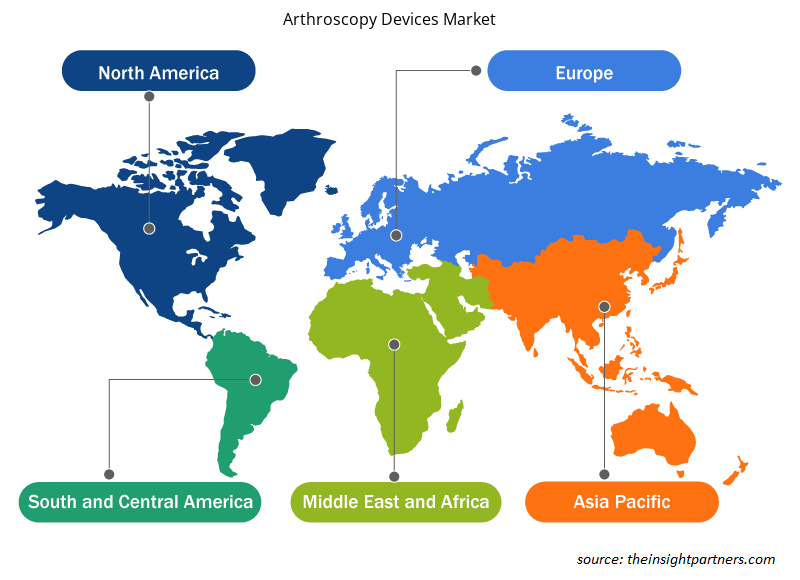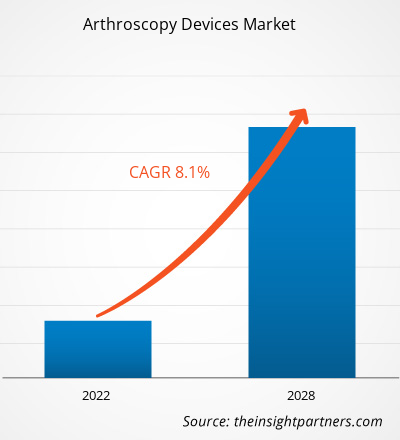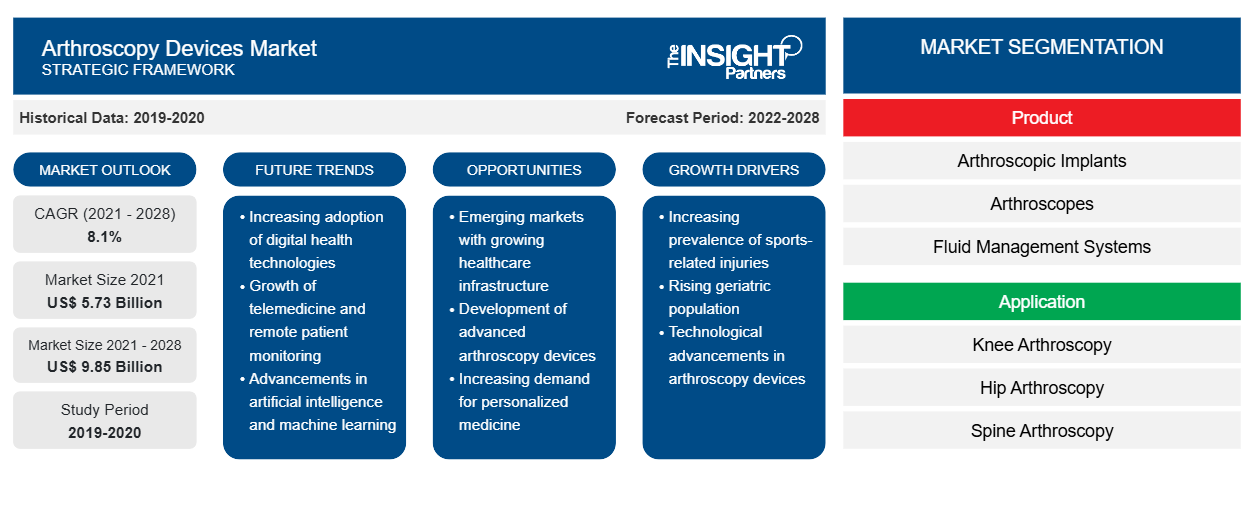Der Markt für Arthroskopiegeräte soll von 5.725,24 Millionen US-Dollar im Jahr 2021 auf 9.853,88 Millionen US-Dollar im Jahr 2028 anwachsen; für den Zeitraum von 2021 bis 2028 wird eine durchschnittliche jährliche Wachstumsrate (CAGR) von 8,1 % erwartet.
Arthroskopie ist ein Verfahren zur Diagnose und Behandlung von Gelenkproblemen. Ein Chirurg führt durch einen kleinen Einschnitt von der Größe eines Knopflochs ein schmales Rohr ein, das an eine Glasfaser-Videokamera angeschlossen ist. Das sogenannte Arthroskop wird verwendet. Ein Arthroskop ist ein medizinisches Gerät, mit dem Ärzte in Körpergelenke wie Knie, Hüfte, Wirbelsäule, Schulter und Ellenbogen hineinsehen können, um sie zu untersuchen, zu diagnostizieren und therapeutische Verfahren durchzuführen. Arthroskopiegeräte können Erkrankungen wie Osteoarthritis, rheumatoide Arthritis, Sehnenentzündung und Knochentumore in den Gelenken untersuchen.
Der Bericht bietet Einblicke und eine eingehende Analyse des Marktes für Arthroskopiegeräte und hebt dabei verschiedene Parameter wie Markttrends, technologische Fortschritte und Marktdynamik hervor. Er bietet auch eine Wettbewerbslandschaftsanalyse führender Marktteilnehmer weltweit. Darüber hinaus umfasst er die Auswirkungen der COVID-19-Pandemie auf den Markt in allen Regionen. Die COVID-19-Pandemie verursachte sowohl eine öffentliche Gesundheitskrise als auch eine weltweite Wirtschaftskrise. Vor der Pandemie wuchs der globale Markt für Arthroskopiegeräte ständig, da regelmäßige Screenings, Beratungen und Behandlungen durchgeführt wurden. Die erste Welle von COVID-19 unterbrach die Konsultationen, Nachuntersuchungen und Screenings onkologischer Fälle. Die unkontrollierte Situation entstand weltweit im Gesundheitswesen und führte zu einer geringeren Anzahl von Konsultationen und einer geringeren Anzahl diagnostizierter Fälle von Osteoarthritis und rheumatoider Arthritis . Mehrere Unternehmen erlitten im letzten Quartal 2019 schwere Verluste; die Pandemie wirkte sich auch negativ auf das erste und zweite Quartal 2020 aus. Daher waren die Auswirkungen der COVID-19-Pandemie auf den Weltmarkt unmittelbar und drastisch. Die Geschäftstätigkeit weltweit wurde durch Störungen in der Lieferkette und eine erhöhte Nachfrage nach Gesundheitsprodukten und -dienstleistungen beeinträchtigt. Um die COVID-19-Infektion in Krankenhäusern und Kliniken einzudämmen, griffen Gesundheitsfachkräfte und Patienten auf die Fernbehandlung von Patienten zurück und bevorzugten diese. Unter diesen unvorhersehbaren Umständen konnte die orthopädische Praxis nicht unberührt bleiben. Viele chirurgische Behandlungen und nicht dringende Konsultationen wurden abgesagt oder verschoben. Wahloperationen wurden in vielen Einrichtungen ausgesetzt, und das Gesamtvolumen der orthopädischen Fälle ging drastisch zurück, um die Ausbreitung des Virus einzudämmen und Ressourcen für Gesundheitspersonal (Krankenschwestern, Anästhesisten), medizinische Geräte (persönliche Schutzausrüstung, Beatmungsgeräte) und Betten zu reservieren und neu zu verteilen. Die „Stay at Home“-Strategie in der Welt führte zu einer deutlichen Reduzierung der Arthroplastik- und Arthroskopieoperationen sowie zu einem Rückgang der Osteoarthritis-Fälle während des COVID-19-Zeitraums.
Passen Sie diesen Bericht Ihren Anforderungen an
Sie erhalten kostenlose Anpassungen an jedem Bericht, einschließlich Teilen dieses Berichts oder einer Analyse auf Länderebene, eines Excel-Datenpakets sowie tolle Angebote und Rabatte für Start-ups und Universitäten.
- Holen Sie sich die wichtigsten Markttrends aus diesem Bericht.Dieses KOSTENLOSE Beispiel umfasst eine Datenanalyse von Markttrends bis hin zu Schätzungen und Prognosen.
Da die Gesundheitsinfrastruktur aufgrund des COVID-19-Ausbruchs gestört war und der Schwerpunkt auf die Behandlung von COVID-19 verlagert wurde, wurde die Diagnose verschiedener Krankheiten vernachlässigt. Darüber hinaus wurden auch die Erkennung und Behandlung von Erkrankungen des Bewegungsapparats durch die COVID-19-Pandemie behindert. Dies hat das Wachstum des Marktes für Arthroskopiegeräte weltweit erheblich gebremst.
Markteinblicke
Zunehmende Prävalenz von Muskel-Skelett-Erkrankungen treibt den Markt an
Muskel-Skelett-Erkrankungen ( MSDs ) sind weltweit die häufigsten Gesundheitsprobleme. Laut den von der Weltgesundheitsorganisation (WHO) veröffentlichten Daten litten im Februar 2021 weltweit etwa 1,71 Milliarden Menschen an Muskel-Skelett-Problemen. Schmerzen im unteren Rücken sind eine weit verbreitete Muskel-Skelett-Erkrankung, von der weltweit 568 Millionen Menschen betroffen sind. Schmerzen im unteren Rücken sind in 160 Ländern die Hauptursache für Behinderungen. Muskel-Skelett-Erkrankungen beeinträchtigen die Mobilität und Geschicklichkeit erheblich und führen zu vorzeitiger Verrentung, vermindertem Wohlbefinden und eingeschränkter Fähigkeit zur Sozialisation. Die Zahl der Menschen, die durch Muskel-Skelett-Erkrankungen behindert sind, wächst, und dieser Trend dürfte sich in den nächsten Jahrzehnten fortsetzen.
Laut WHO sind Länder mit hohem Einkommen gemessen an ihrer Bevölkerungszahl (441 Millionen) am stärksten betroffen, gefolgt von Ländern im WHO-Raum Westpazifik mit 427 Millionen, während Südostasien 369 Millionen Einwohner hat. Muskel-Skelett-Erkrankungen sind auch die Hauptursache für viele Jahre mit Behinderung weltweit : Sie machen etwa 149 Millionen Jahre oder 17 % aller Jahre mit Behinderung aus . Knochenbrüche, von denen weltweit 436 Millionen Menschen betroffen sind, Osteoarthrose (343 Millionen), andere Verletzungen (305 Millionen), Nackenschmerzen (222 Millionen), Amputationen (175 Millionen) und rheumatoide Arthritis (14 Millionen) tragen allesamt zur Gesamtbelastung durch Muskel-Skelett-Erkrankungen bei.
Die chirurgische Arthroskopie ist eine bewährte Therapieoption für Personen mit chronischen Gelenkschmerzen und Funktionsstörungen. Im Vergleich zu offenen Gelenkoperationen ist die Arthroskopie weniger invasiv und führt zu besseren Gesamtergebnissen für den Patienten hinsichtlich Symptombehandlung, Krankenhausaufenthalt, struktureller Genesung und Langzeitergebnissen. Daher wird erwartet, dass die zunehmende Verbreitung von Erkrankungen des Bewegungsapparats, Osteoarthritis und rheumatoider Arthritis den Markt im Prognosezeitraum antreiben wird.
Produktbasierte Erkenntnisse
Basierend auf dem Produkt ist der Markt für Arthroskope in Arthroskope, arthroskopische Implantate, Flüssigkeitsmanagementsysteme , Hochfrequenzsysteme , Visualisierungssysteme, Rasierersysteme und andere arthroskopische Geräte unterteilt. Im Jahr 2021 hatte das Segment Arthroskope den größten Marktanteil und wird im Prognosezeitraum voraussichtlich die schnellste durchschnittliche jährliche Wachstumsrate von 9,1 % verzeichnen.
Anwendungsbasierte Erkenntnisse
Basierend auf der Anwendung ist der Markt für Arthroskopiegeräte in Kniearthroskopie, Hüftarthroskopie, Wirbelsäulenarthroskopie, Fuß- und Knöchelarthroskopie, Schulter- und Ellenbogenarthroskopie und andere unterteilt. Im Jahr 2021 hatte das Segment der Hüftarthroskopie den größten Marktanteil und wird voraussichtlich im Zeitraum 2021–2028 die höchste durchschnittliche jährliche Wachstumsrate von 8,9 % verzeichnen.
Die Akteure auf dem Markt für Arthroskopiegeräte verfolgen organische Strategien wie Produkteinführung und -erweiterung, um ihre Präsenz und ihr Produktportfolio weltweit zu erweitern und der wachsenden Nachfrage gerecht zu werden.
Nach Geografie
Geografisch ist der Markt für Arthroskopiegeräte segmentiert in Nordamerika (USA, Kanada und Mexiko), Europa (Großbritannien, Deutschland, Frankreich, Italien, Spanien und übriges Europa), Asien-Pazifik (China, Japan, Indien, Australien, Südkorea und übriger Asien-Pazifik-Raum), Naher Osten und Afrika (VAE , Saudi-Arabien, Südafrika und übriger Naher Osten und Afrika) sowie Süd- und Mittelamerika (Brasilien, Argentinien und übriges Süd- und Mittelamerika).
Regionale Einblicke in den Markt für Arthroskopiegeräte
Die regionalen Trends und Faktoren, die den Markt für Arthroskopiegeräte im Prognosezeitraum beeinflussen, wurden von den Analysten von Insight Partners ausführlich erläutert. In diesem Abschnitt werden auch die Marktsegmente und die Geografie für Arthroskopiegeräte in Nordamerika, Europa, im asiatisch-pazifischen Raum, im Nahen Osten und Afrika sowie in Süd- und Mittelamerika erörtert.

- Erhalten Sie regionale Daten zum Markt für Arthroskopiegeräte
Umfang des Marktberichts zu Arthroskopiegeräten
| Berichtsattribut | Details |
|---|---|
| Marktgröße im Jahr 2021 | 5,73 Milliarden US-Dollar |
| Marktgröße bis 2028 | 9,85 Milliarden US-Dollar |
| Globale CAGR (2021 - 2028) | 8,1 % |
| Historische Daten | 2019-2020 |
| Prognosezeitraum | 2022–2028 |
| Abgedeckte Segmente | Nach Produkt
|
| Abgedeckte Regionen und Länder | Nordamerika
|
| Marktführer und wichtige Unternehmensprofile |
|
Marktteilnehmerdichte für Arthroskopiegeräte: Auswirkungen auf die Geschäftsdynamik verstehen
Der Markt für Arthroskopiegeräte wächst rasant, angetrieben durch die steigende Nachfrage der Endnutzer aufgrund von Faktoren wie sich entwickelnden Verbraucherpräferenzen, technologischen Fortschritten und einem größeren Bewusstsein für die Vorteile des Produkts. Mit steigender Nachfrage erweitern Unternehmen ihr Angebot, entwickeln Innovationen, um die Bedürfnisse der Verbraucher zu erfüllen, und nutzen neue Trends, was das Marktwachstum weiter ankurbelt.
Die Marktteilnehmerdichte bezieht sich auf die Verteilung der Firmen oder Unternehmen, die in einem bestimmten Markt oder einer bestimmten Branche tätig sind. Sie gibt an, wie viele Wettbewerber (Marktteilnehmer) in einem bestimmten Marktraum im Verhältnis zu seiner Größe oder seinem gesamten Marktwert präsent sind.
Die wichtigsten auf dem Markt für Arthroskopiegeräte tätigen Unternehmen sind:
- Arthrex, Inc.
- CONMED-Unternehmen
- Johnson & Johnson Services, Inc.
- KARL STORZ SE & Co. KG
- Medtronic
Haftungsausschluss : Die oben aufgeführten Unternehmen sind nicht in einer bestimmten Reihenfolge aufgeführt.

- Überblick über die wichtigsten Akteure auf dem Markt für Arthroskopiegeräte
Firmenprofile
- Arthrex, Inc.
- CONMED-Unternehmen
- Johnson & Johnson Services, Inc.
- KARL STORZ SE & Co. KG
- Medtronic
- Richard Wolf GmbH.
- Smith & Neffe
- Stryker Corporation
- Zimmer Biomet
- NuVasive, Inc.
- Historische Analyse (2 Jahre), Basisjahr, Prognose (7 Jahre) mit CAGR
- PEST- und SWOT-Analyse
- Marktgröße Wert/Volumen – Global, Regional, Land
- Branchen- und Wettbewerbslandschaft
- Excel-Datensatz
Aktuelle Berichte
Erfahrungsberichte
Grund zum Kauf
- Fundierte Entscheidungsfindung
- Marktdynamik verstehen
- Wettbewerbsanalyse
- Kundeneinblicke
- Marktprognosen
- Risikominimierung
- Strategische Planung
- Investitionsbegründung
- Identifizierung neuer Märkte
- Verbesserung von Marketingstrategien
- Steigerung der Betriebseffizienz
- Anpassung an regulatorische Trends





















 Kostenlose Probe anfordern für - Markt für Arthroskopiegeräte
Kostenlose Probe anfordern für - Markt für Arthroskopiegeräte